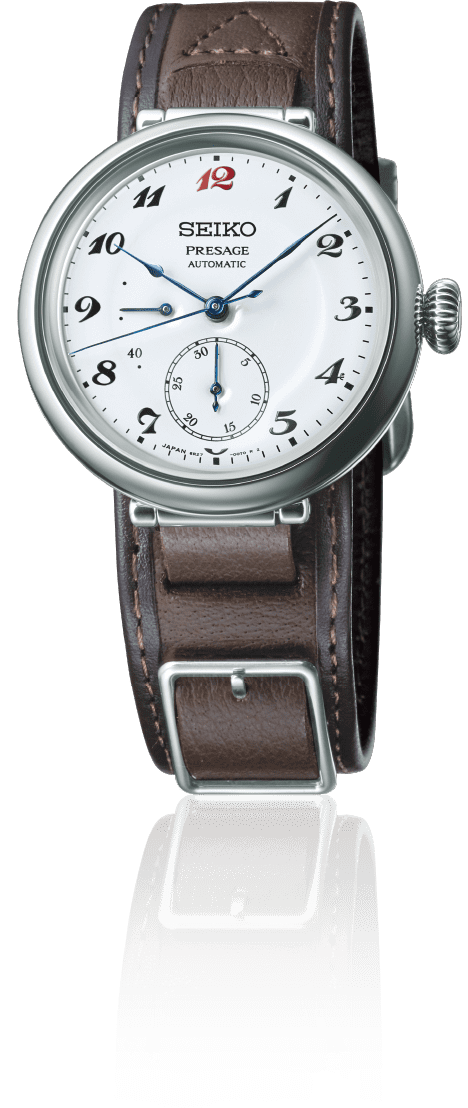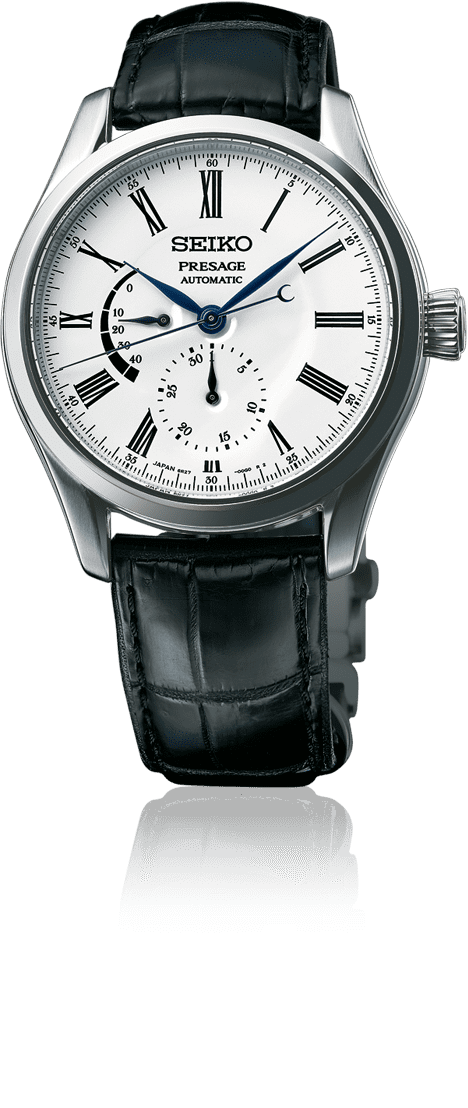Seiko Presage brings time-honored craftsmanship and a uniquely Japanese aesthetic to the world through its watches. Join us on a journey to Ibaraki. We’ll explore the land, the culture, and the traditional master craftsmanship behind this distinctive timepiece with an enamel dial.
Seiko Presage
Craftsmanship Series
Enamel Dial
Uniquely Japanese –
Transcending time and place
Enamel has a texture that captures a feeling of warmth from its unique soft sheen and an appearance that retains its beautiful color for a very long time.
The Seiko Presage Enamel Dial model was created by a master craftsman
in collaboration with the precision manufacturing of Seiko’s engineers. Year after year, watches with this beautiful dial continue to delight the eyes of everyone who has one.
An artistic technology, blending science with nature

An artistic technology, blending science with nature
Enamel has a long and illustrious history. The oldest examples have been found around the Aegean Sea, dating from the 15th century BC. First introduced to Japan around the 7th century, it was used on swords and precious artifacts. As Japan modernized, enamel became widely used for household goods like kitchenware, and soon it was used for many things, including bathtubs, building materials, and medical devices.
Much as San Francisco benefits from its proximity to Silicon Valley and the Napa Valley, Tokyo also prospers by being adjacent to Ibaraki, a global hub for high tech and innovation that is also blessed with a pristine natural landscape. The artisans who make the Seiko Presage enamel dial are proudly inspired by Ibaraki prefecture’s abundance of natural splendor, its modern industry, and its legacy in Japan’s history. Join us as we explore the many beautiful and fascinating aspects of Ibaraki.
The simple meal of local fishermen becomes a gourmet dish
Going by looks, the monkfish could easily be an evil character in a manga comic, yet it is a famous delicacy of Japanese cuisine and has been Ibaraki’s winter specialty for hundreds of years. When skillfully prepared, monkfish is entirely edible except for the bones. The al dente white meat is full of protein, the skin and intestines are rich in collagen and vitamins, and monkfish soup (made with either miso paste or soy sauce and plenty of vegetables) is full of healthy fiber. The liver, or ankimo, often called “sea foie-gras”, is particularly popular with foreigners, though it is becoming a rare and luxurious delicacy in Japan as well.
Ibaraki is one of the main sweet potato growing areas in Japan. Delicious and extremely nutritious, satsumaimo has a mild, sweet, earthy taste when eaten cold, and a tantalizing gooey texture when freshly baked. In Tsukuba, you can find old-fashioned baking huts using natural wood-fired ovens. One can purchase a yaki imo, or baked sweet potato, at a very reasonable price. Enjoy its rich yellow essence while breathing in the steam from its flesh.
Evolving and refined beauty
Mitsuru Yokosawa, Enamel Master CraftsmanFor more than fifty years, veteran craftsman Mitsuru Yokosawa has been passionate about his high-quality technique. He began working with enamel in 1971, when he joined Fuji Porcelain Enamel Co., Ltd. In a feat closely resembling magic, Mr. Yokosawa and his most trusted apprentices are able to apply enamel to a component as delicately crafted as a Seiko watch dial.
“Enamel dials have existed since the first Seiko wristwatch, the Laurel of 1913, and I have been working with the Presage watch that follows in this heritage,” says Yokosawa. “The layers of enamel I can apply are getting thinner and thinner. I must adjust the spray by applying just the slightest pressure from my fingertips to shift the composition ratio of the enamel glaze. It seems to me the challenge never gets easier. The glaze is highly susceptible to changes in ambient temperature and humidity; therefore, the process not only requires harmony between the brain, eyes, and hands, but sensibility to the surroundings and a whole lot of experience.”
“To attain such a level of concentration you almost need to levitate.” Yokosawa continues, grinning. "I am enthusiastically working on teaching younger generations in order to pass on this technique" he adds. “There is such a wonderful feeling of accomplishment when I see the final product in my hands or when I think that this beautifully crafted watch might travel across the world to special customers, who value it so much as to hand it from one generation to another.”
For more than fifty years, veteran craftsman Mitsuru Yokosawa has been passionate about his high-quality technique. He began working with enamel in 1971, when he joined Fuji Porcelain Enamel Co., Ltd. In a feat closely resembling magic, Mr. Yokosawa and his most trusted apprentices are able to apply enamel to a component as delicately crafted as a Seiko watch dial.
“Enamel dials have existed since the first Seiko wristwatch, the Laurel of 1913, and I have been working with the Presage watch that follows in this heritage,” says Yokosawa. “The layers of enamel I can apply are getting thinner and thinner. I must adjust the spray by applying just the slightest pressure from my fingertips to shift the composition ratio of the enamel glaze. It seems to me the challenge never gets easier. The glaze is highly susceptible to changes in ambient temperature and humidity; therefore, the process not only requires harmony between the brain, eyes, and hands, but sensibility to the surroundings and a whole lot of experience.”
“To attain such a level of concentration you almost need to levitate.” Yokosawa continues, grinning. "I am enthusiastically working on teaching younger generations in order to pass on this technique" he adds. “There is such a wonderful feeling of accomplishment when I see the final product in my hands or when I think that this beautifully crafted watch might travel across the world to special customers, who value it so much as to hand it from one generation to another.”
More than 100 years of perfection
The Seiko Laurel of 1913 was the first wristwatch made in Japan. A limited edition of 2,500 Seiko Presage Enamel Dial watches, designed as an homage to the original Laurel, will be released in celebration of the 110th anniversary of its inauguration. In an ever-changing world, this watch embodies the unwavering Seiko spirit of being at the forefront of Japanese watchmaking and master craftsmanship. This dial-making process and the resulting special art piece will live on for more than another 100 years.
Did you enjoy our journey through Ibaraki, from the ancient past to the futuristic present? We hope you delighted in the hidden splendor of Japan revealed on this virtual tour. It evokes the passion, dedication, and culture that gave rise to the Seiko Presage Enamel Dial model. Meanwhile, our voyage of discovery in Seiko Presage craftsmanship continues. We look forward to having you join us once again in the next installment.






 TOP
TOP